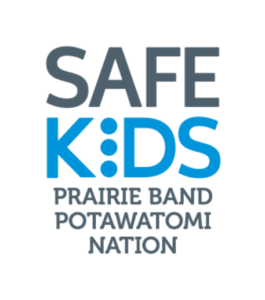
As you know, too many loved ones, co-workers, family members, and community members have been lost due to motor vehicle crashes on US 75 Highway while crossing the highway. Safe Kids Prairie Band Potawatomi Nation is asking everyone to help reduce the chances of motor vehicle crashes and fatalities on this dangerous highway.
You can help with this by doing the following:
• Always wear your seat belt.
• Always have kids under the age of 8 years old or 80 pounds properly installed in a car seat.
• Always keep children rear-facing in a car seat until the car seat manufacture recommends forward-facing.
• Ensure your vehicle is free of debris that could be tossed around if involved in a motor vehicle crash that could injure someone inside of the vehicle.
• Make sure to stop at all stop signs and look both ways before proceeding.
• Make sure to yield at all yield signs and look both ways before proceeding.
• Try to avoid dangerous intersections:
o Anyone who is traveling to or from the Topeka Area, or Holton area can use 150th Road at all times when entering or exiting US 75 Highway.
o Anyone exiting the PBPN Common Land into the city of Mayetta can use 150th Road at all times and travel north on US 75 Highway to Mayetta.
The following is data from the 2020-2024 Kansas Strategic Highway Safety Plan:
1. Almost one in four Kansas crash fatalities happens at an intersection. Intersection-related fatalities represent roughly 21 percent of all crash fatalities in Kansas. Between 2014 and 2018, 445 fatalities and 1,709 serious injuries occurred at intersections. In that span, intersection crashes accounted for 30 percent of serious injury crashes statewide and 31 percent of all crashes. Increases and decreases in intersection fatalities and serious injuries tend to parallel the pattern of fatalities and serious injuries overall.
2. The most likely crash: collisions between vehicles. More than 80 percent of intersection crashes are collisions between motor vehicles. Rear-end and angle/side-impact crashes are the most common types. The data indicates that our focus should be on reducing the potential for these conflicts. Reducing angle crashes begins with good engineering, but also depends on drivers’ recognition of intersection type and law enforcement. Rear-end crashes along signalized corridors can be reduced by such means as timed signals and turn lanes. Between 2014 and 2018, collisions between motor vehicles accounted for 84 percent of the fatalities and 82 percent of the serious injuries at intersections. Of these, 76 percent were angle collisions (left-turn and right-angle), 15 percent rear-end.
3. The contribution of driver behavior to intersection collisions. Most intersection fatalities are the result of a collision between two vehicles and most of those collisions are identified as angle/side impact. Given this information, it’s not surprising that “failure to yield right-of-way” and “disregarded traffic signs, signals or markings” represent two of the top three factors involved in collisions. Use of handheld communication devices inside and outside of vehicles has skyrocketed within the last decade. Given this trend, it’s not surprising that “inattention/ distracted driving” is noted as the fourth largest contributor to intersection crashes. The remaining factor in the top four is “driving while impaired by alcohol or drugs,” and is all too familiar.
In most intersection fatalities, at least one of the drivers involved makes a poor decision. Intersections are a planned point of conflict in the roadway system. Each intersection has a number of potential conflict points. A standard four-legged intersection has 32 conflict points—32 opportunities for a driver to make a mistake. Roundabouts, by comparison, have only eight. Engineering, as well as enforcement, education and emergency medical services can only go so far. In the end, the success of the Kansas Strategic Highway Safety Plan depends largely on the drivers.
